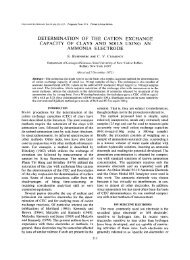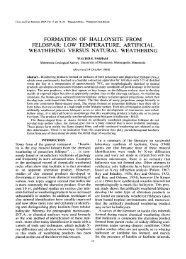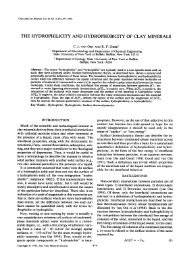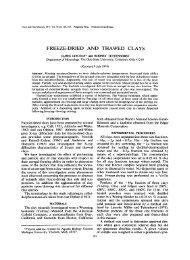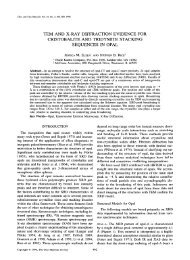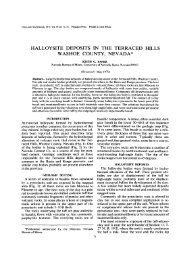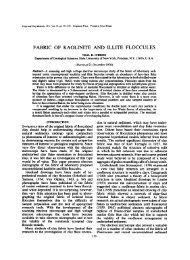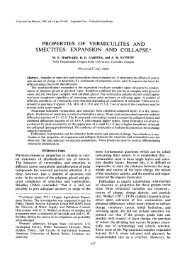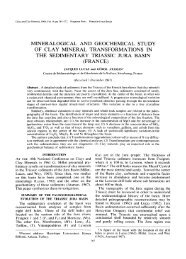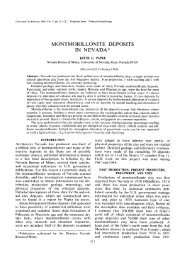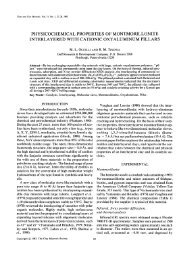mechanisms of gibbsite crystallization from partially neutralized ...
mechanisms of gibbsite crystallization from partially neutralized ...
mechanisms of gibbsite crystallization from partially neutralized ...
You also want an ePaper? Increase the reach of your titles
YUMPU automatically turns print PDFs into web optimized ePapers that Google loves.
Clays and Clay Minerals, Vol. 36, No. 1, 25-30, 1988.<br />
MECHANISMS OF GIBBSITE CRYSTALLIZATION FROM PARTIALLY<br />
NEUTRALIZED ALUMINUM CHLORIDE SOLUTIONS 1<br />
PA HO Hsu<br />
Department <strong>of</strong> Soils and Crops, Rutgers<br />
The State University <strong>of</strong> New Jersey, New Brunswick, New Jersey 08903<br />
Abstract--To interpret the erratic conditions, rates, and extent <strong>of</strong> <strong>gibbsite</strong> <strong>crystallization</strong> <strong>from</strong> <strong>partially</strong><br />
<strong>neutralized</strong> A1C13 solution, the following hypothesis is proposed: The initial OH-AI polymers in the freshly<br />
prepared solutions were probably unstable and transformed into either <strong>gibbsite</strong> or stable OH-AI polymers<br />
via two different reaction paths. In the presence <strong>of</strong> nuclei, the OH-A1 polymers dissociated into monomeric<br />
ions, which then deposited onto nuclei to form <strong>gibbsite</strong>. In the absence <strong>of</strong> nuclei, the unstable polymers<br />
slowly converted to stable polymers. The erratic stability <strong>of</strong> OH-A1 solutions and <strong>gibbsite</strong> <strong>crystallization</strong><br />
are therefore attributed to the relative magnitudes <strong>of</strong> these two reaction paths which, in turn, are attributed<br />
to two key factors: (1) the distribution <strong>of</strong> unstable vs. stable OH-A1 polymers; and (2) the presence or<br />
absence <strong>of</strong> nuclei. The duration <strong>of</strong> aging <strong>of</strong> the parent solution governed the distribution <strong>of</strong> unstable vs.<br />
stable polymers. The rate <strong>of</strong> neutralization resulted in varying localized high alkalinity in OH-AI solution<br />
preparation and thus varying development <strong>of</strong> nuclei.<br />
Key Words--Aluminum hydroxide, Crystallization, Gibbsite, OH-A1 polymer, Nucleation.<br />
INTRODUCTION<br />
By adding a dilute base to an A1 salt solution, clear<br />
solutions may be obtained at OH/A1 molar ratios as<br />
high as 2.5, or even 2.7 if the neutralization is carried<br />
out slowly (Hsu, 1977). The presence <strong>of</strong> OH-AI poly-<br />
mers in such <strong>partially</strong> <strong>neutralized</strong> A1 solutions has long<br />
been recognized. Many <strong>of</strong> these solutions, however,<br />
become turbid, and aluminum hydroxide develops af-<br />
ter prolonged aging (Hsu, 1966, 1977; Turner and Ross,<br />
1970; Smith, 1971; Smith and Hem, 1972; Turner,<br />
1976a; Tsai and HSU , 1985). Nevertheless, the reported<br />
conditions, rates, and extent <strong>of</strong><strong>gibbsite</strong> <strong>crystallization</strong><br />
<strong>from</strong> partly <strong>neutralized</strong> A1 solutions are highly vari-<br />
able. For example, some solutions <strong>of</strong> NaOH/A1 molar<br />
ratio = 1 prepared by this investigator remained clear<br />
to the naked eye, having a turbidity reading <strong>of</strong> < 1 FTU<br />
(Formazin turbidity unit) for more than 10 yr (Tsai<br />
and Hsu, 1984). Occasionally, however, some solu-<br />
tions became turbid and developed <strong>gibbsite</strong> after a few<br />
months <strong>of</strong> aging. For solutions <strong>of</strong> NaOH/AI molar ra-<br />
tio = 2.2, <strong>gibbsite</strong> developed <strong>from</strong> all preparations, but<br />
the amount <strong>of</strong> <strong>gibbsite</strong> developed varied <strong>from</strong> 2.7% in<br />
34 mo in one sample to 47% in 18 mo in another (Tsai<br />
and Hsu, 1985). The OH-A1 polymers initially formed<br />
in freshly prepared solutions were probably unstable<br />
and converted to either stable OH-A1 polymers or gibb-<br />
site via two different reaction paths. The erratic crys-<br />
tallization <strong>of</strong> <strong>gibbsite</strong> was likely governed by the rel-<br />
ative magnitude <strong>of</strong> these two reaction paths. The<br />
objective <strong>of</strong> the present study was to test this inter-<br />
pretation.<br />
New Jersey Agricultural Experiment Station Publication<br />
No. D-15420-1-86.<br />
Copyright 9 1988, The Clay Minerals Society 25<br />
MATERIALS AND METHODS<br />
Preparation <strong>of</strong> OH-Al solutions<br />
Partially <strong>neutralized</strong> aluminum chloride solutions<br />
having OH-A1 molar ratios <strong>of</strong> 0 to 2.5 were prepared<br />
by dropwise addition <strong>of</strong> appropriate amounts <strong>of</strong> 0.1 M<br />
NaOH to 400 ml <strong>of</strong> a freshly prepared 0.1 M AIC13<br />
solution and then diluted to 2000 ml. In most prepa-<br />
rations, NaOH was added at a rate <strong>of</strong> 1 ml/min. To<br />
study the effect <strong>of</strong> neutralization rates, NaOH was added<br />
at different rates as described below. To study the effect<br />
<strong>of</strong> seed addition, 5 ml <strong>of</strong> a seeding solution was added<br />
to 500 ml <strong>of</strong> <strong>partially</strong> <strong>neutralized</strong> OH-A1 solutions.<br />
According to Tsai and Hsu (1984, 1985), polymeric<br />
OH-A1 complexes in a partly <strong>neutralized</strong> solution slow-<br />
ly change with time. To compare the different OH-A1<br />
polymers in their rates <strong>of</strong> <strong>gibbsite</strong> <strong>crystallization</strong>, the<br />
parent solutions, aged for various durations, were used<br />
in this study. Gibbsite crystallites prepared in previous<br />
studies were used to seed solutions <strong>of</strong> either OH/A1 =<br />
1 or 2.2.<br />
Analysis <strong>of</strong> samples<br />
Solutions were periodically analyzed for changes in<br />
pH, turbidity, and the concentration and nature <strong>of</strong> A1<br />
ions in solution. The Ai ions in solution were speciated<br />
using the kinetics <strong>of</strong> AI-Ferron color development (Tsai<br />
and Hsu, 1984). The solution p(A13+)(on-) 3 activity<br />
product was calculated <strong>from</strong> the solution pH and the<br />
concentration <strong>of</strong> monomeric A1 ions using pK1 = 5.01<br />
for AP + hydrolysis (Frink and Peech, 1963) and the<br />
Davis equation for the activity coefficient. Samples that<br />
became turbid during aging were centrifuged through<br />
Millipore filter papers <strong>of</strong> appropriate pore size, using
26 Hsu Clays and Clay Minerals<br />
a Millipore centrifugation apparatus to separate any<br />
suspended particles <strong>from</strong> solution. The filtration usually<br />
started with filter paper <strong>of</strong> 0.22-gm pore size. If<br />
a2<br />
the filtrate was not clear, it was refiltered with a smaller<br />
pore size until the filtrate had a turbidity <strong>of</strong> < 1 FTU.<br />
7-.<br />
The filtrates were analyzed for the concentration and<br />
nature <strong>of</strong> A1 ions present. The amount <strong>of</strong> aluminum<br />
o a a<br />
in precipitate was estimated <strong>from</strong> the reduction <strong>of</strong> A1 T~<br />
v 34 ....<br />
concentration in solution. The precipitate was analyzed<br />
with Siemens X-ray powder diffraction (XRD) equip-<br />
ment for its mineralogical composition and with a JEM<br />
3~<br />
100 CX transmission electron microscope for particle 0<br />
size and morphology. The specimen for XRD was pre-<br />
pared by centrifuging a suitable aliquot through a Mil-<br />
lipore filter paper. The filter paper containing the pre-<br />
cipitate was pasted onto a glass slide and X-rayed. The<br />
specimen for electron microscopy was prepared by<br />
placing one drop <strong>of</strong> suspension onto a copper grid and<br />
drying it.<br />
Reaction <strong>of</strong> OH-Al solutions with acid<br />
Two milliliters <strong>of</strong> 1.0 M HCI were added to 100 ml<br />
<strong>of</strong> OH-AI solution (0.02 M AI, OH/AI = 1), and the<br />
change in pH with time was recorded continuously<br />
during the first 3 hr and then periodically afterwards<br />
until equilibrium was attained. Three solutions that<br />
had been aged for 1 day, 1 year, and 3 years were<br />
studied to compare the reaction rates <strong>of</strong> the different<br />
OH-AI polymers with acid. A series <strong>of</strong> standard A1CI3-<br />
HC1 solutions was prepared by adding various amounts<br />
<strong>of</strong> 1.0 M HC1 and H20 to 100 ml <strong>of</strong> 0.02 M A1CI3.<br />
The sum <strong>of</strong> HC1 and H20 was also 2 ml, so that the<br />
final A1 concentration <strong>of</strong> all samples and standards was<br />
0.0196 M. A calibration curve was constructed <strong>from</strong><br />
these standard AIC13-HC1 solutions to calculate the<br />
amounts <strong>of</strong> H § consumed during reaction.<br />
General chemical analys&<br />
Solution pH was determined with a Fisher 825 Ac-<br />
cumet pH meter. Turbidity was measured with a Hach<br />
Model 2100 turbidity meter. Total AI in solution was<br />
determined with Ferron after acid decomposition <strong>of</strong><br />
the polymeric species similar to the Aluminon proce-<br />
dure (Hsu, 1963). The detailed procedures were de-<br />
scribed in an earlier report (Tsai and Hsu, 1984).<br />
RESULTS AND DISCUSSION<br />
Solution (AP+J(OH-) ~ activity product<br />
The p(A13+)(OH-)3 activity products for a series <strong>of</strong><br />
freshly prepared OH-A1 solutions are calculated <strong>from</strong><br />
their concentrations <strong>of</strong> monomeric AI species and pH<br />
(Figure 1). The results show that all solutions were<br />
supersaturated with respect to <strong>gibbsite</strong>, the negative<br />
logarithm <strong>of</strong> the solubility product <strong>of</strong> <strong>gibbsite</strong> being<br />
34.03 (Kittrick, 1966) or 33.96 (Singh, 1974).<br />
j 0___---.-~ 0 ~<br />
~0~0~0~0 jO<br />
PKsp glbbalte<br />
! | I ! I<br />
0.5 1.0 1.5 2.0 2.5<br />
NaOH/AI molar ratio in preparation<br />
Figure 1. Solution p(A13+)(OH-)3 activity product for <strong>partially</strong><br />
<strong>neutralized</strong> 0.02 M AICI3 solutions.<br />
Effect <strong>of</strong> seed addition<br />
A precipitate was formed in all OH/A1 = 1 solutions<br />
after they had been seeded with aluminum hydroxide<br />
crystallites. The precipitate was identified as <strong>gibbsite</strong><br />
by XRD. The initial precipitate showed a broad peak<br />
corresponding to the basal spacing <strong>of</strong> 4.84 A, but the<br />
crystallinity rapidly improved with time. A complete<br />
series <strong>of</strong> XRD peaks characteristic <strong>of</strong> <strong>gibbsite</strong> was ob-<br />
served in all samples shortly after the solutions became<br />
turbid. The rates and extent <strong>of</strong><strong>gibbsite</strong> <strong>crystallization</strong>,<br />
however, greatly decreased with increased duration <strong>of</strong><br />
aging <strong>of</strong> the parent OH-A1 solutions (Table 1). Gibbsite<br />
precipitation was accompanied by decreases in pH and<br />
in unstable polymers and an increase in the concen-<br />
tration <strong>of</strong> monomeric AI species. The amount <strong>of</strong> stable<br />
polymer increased slightly at the early stage <strong>of</strong> aging.<br />
Once <strong>gibbsite</strong> <strong>crystallization</strong> was noticeable, the amount<br />
<strong>of</strong> stable OH-A1 polymers practically remained un-<br />
changed. The 12-yr-old parent solution contained only<br />
a very small amount <strong>of</strong> unstable polymer, and only a<br />
trace <strong>of</strong> <strong>gibbsite</strong> was observed 564 days after seeding.<br />
The amount <strong>of</strong> stable polymer remained practically<br />
unchanged during the entire period <strong>of</strong> the experiment.<br />
In contrast, all controls (parent OH-AI solutions) re-<br />
mained clear for as long as 348 days after the experi-<br />
mentation began. The concentrations <strong>of</strong> unstable poly-<br />
mers slowly decreased, whereas those <strong>of</strong> stable polymers<br />
increased with time, similar to the results reported by<br />
Tsai and Hsu (1984). Table 1 also shows that the con-<br />
centration <strong>of</strong> unstable polymers decreased at a much<br />
faster rate in seeded solutions in which a large amount<br />
<strong>of</strong> <strong>gibbsite</strong> had developed than in the controls, which<br />
remained clear throughout the experimentation.<br />
The fresh and aged solutions were also very different<br />
in their rates <strong>of</strong> reaction with acid (Figure 2). With a<br />
1-day-old solution, 74O/o <strong>of</strong> H § was consumed in the<br />
first hour and 91% in 5 hr. The neutralization practi-<br />
cally reached equilibrium in 24 hr. In contrast, the<br />
1-yr-old and 3-yr-old OH-A1 solutions took more than
Vol. 36, No. 1, 1988 Gibbsite <strong>crystallization</strong> 27<br />
Table 1. Effect <strong>of</strong> seed addition on the <strong>crystallization</strong> <strong>of</strong> <strong>gibbsite</strong> and accompanying changes in soluble AI species (rag AI/<br />
liter) <strong>from</strong> OH/AI = 1 solutions during prolonged aging.<br />
Control (mg Al/liter) Seed added 2 (m s AUliter)<br />
Reaction AI(OH)3 p(AP +) AI(OH)3 p(AP +)<br />
time I (days) pH Mono 3 USP ~ SP 3 ppt (OH-) 3 pH Mono 3 USP ~ SP 3 ppt (OH-) 3<br />
Age <strong>of</strong>parentsolution(B422) = 4days<br />
2 4.04 292 212 nil nil 32.59 4.04 292 212 nil nfl 32.59<br />
33 4.06 269 215 49 nfl 32.56<br />
68 3.98 314 178 22 ~ 32.77<br />
158 3.97 327 87 37 83 32.76<br />
221 3.85 348 46 40 135 33.10<br />
293 3.89 303 155 72 nU 33.02 3.64 329 31 43 139 33.74<br />
348 3.93 306 129 80 nfl 32.90 3.63 324 30 37 145 33.74<br />
585 3.99 297 102 109 nil 32.73 3.65 319 38 36 154 33.72<br />
Age <strong>of</strong> parent solution (B306) = 219 days<br />
2 4.05 280 178 58 nil 32.57 4.05 280 178 58 nfl 32.57<br />
33 3.99 284 153 75 nil 32.74<br />
68 4.00 298 146 70 W 32.70<br />
108 3.97 310 114 76 35 32.78<br />
158 3.95 324 68 76 75 32.82<br />
221 3.84 315 32 73 114 32.16<br />
293 3.87 308 123 104 nil 33.08 3.64 313 33 84 113 33.76<br />
348 3.93 295 78 143 nil 32.91 3.65 306 42 86 108 33.73<br />
585 3.98 298 65 130 25 32.76 3.70 308 40 78 110 33.58<br />
Age <strong>of</strong>parentsolution(B304)= 484 days<br />
2 4.02 297 118 106 nil 32.64 4.02 297 118 106 nfl 32.64<br />
33 4.03 288 120 102 nil 32.62<br />
68 3.97 306 106 114 14 32.78<br />
108 3.97 324 72 118 34 32.76<br />
158 3.95 325 39 116 63 32.82<br />
221 3.82 307 27 114 84 33.23<br />
348 3.92 284 76 151 nil 32.95 3.67 309 20 110 91 33.67<br />
585 3.96 298 61 153 nil 32.82 3.69 309 30 110 87 33.61<br />
Age <strong>of</strong> parent solution (B302) = 604 days<br />
2 4.02 287 110 112 nil 32.66 4.02 287 110 112 nil 32.66<br />
33 4.03 296 101 123 nil 32.62<br />
68 3.97 305 81 123 ~ 32.78<br />
108 3.96 333 58 132 35 32.78<br />
158 3.93 337 34 130 62 32.87<br />
221 3.80 305 24 125 74 33.29<br />
293 3.89 308 70 150 nfl 33.02 3.64 317 37 137 45 33.75<br />
348 3.92 293 67 160 nil 32.94 3.69 306 20 121 80 33.61<br />
585 3.95 300 54 150 ~ 32.85 3.70 307 40 121 78 33.58<br />
Parentsolution, 12yr(Z1)<br />
564 3.82 292 20 209 nil 33.24 3.78 295 18 202 tr 33.36<br />
After seed addition.<br />
2 Seeded with submicrometer <strong>gibbsite</strong> crystallite suspension, 5 ml/500 ml.<br />
3 Mono = monomerie AI; USP = unstable OH-A1 polymers; SP = stable OH-AI polymers.<br />
30 days to reach a neutral pH, providing additional<br />
evidence that the OH-A1 polymers in solution gradu-<br />
ally increased in stability during aging.<br />
For OH/AI = 2.2 solutions, <strong>gibbsite</strong> was observed<br />
in all preparations after prolonged aging (Tsai and Hsu,<br />
1985), but the precipitation <strong>of</strong> <strong>gibbsite</strong> accelerated<br />
markedly with seeding (Table 2). The results listed in<br />
Table 2 also show that, prior to the start <strong>of</strong> <strong>gibbsite</strong><br />
<strong>crystallization</strong>, the unstable polymers slowly converted<br />
to stable polymers with time. Once the solution con-<br />
dition favored <strong>gibbsite</strong> <strong>crystallization</strong>, the concentra-<br />
tion <strong>of</strong> unstable polymers decreased at a much faster<br />
rate, whereas that <strong>of</strong> stable polymers indicated little<br />
change with time. The final p(AI3+)(OH-)3 activity<br />
products for all OH/AI = 1 or 2.2 solutions seem to<br />
reach a constant value <strong>of</strong> 33.72, slightly higher than<br />
the reported pimp <strong>of</strong> <strong>gibbsite</strong> (34.03, Kittrick, 1966;<br />
33.96, Singh, 1974).<br />
The results may be interpreted by assuming that the<br />
initial polymers present in freshly prepared solutions<br />
were unstable and converted to either <strong>gibbsite</strong> or stable<br />
polymers via two different reaction paths. The relative<br />
magnitudes <strong>of</strong> these two reaction paths were governed<br />
by: (1) the distribution <strong>of</strong> unstable and stable OH-A1
28 Hsu Clays and Clay Minerals<br />
o ~-/ j~k4 D<br />
~ d.-o<br />
,, / . 7 ~ ~<br />
"I"<br />
0 7 / ,./"<br />
0.1 015 i g 10 10 160 500 1600<br />
Time <strong>of</strong> reaction (hr)<br />
Figure 2. Neutralization <strong>of</strong> polymer-OH in three <strong>partially</strong><br />
<strong>neutralized</strong> 0.02 M AIC13 solutions (OH/A1 = 1) with HCI:<br />
(a) 1 day old; (b) 1 yr old; (c) 3 yr old. (2 meq HC1 added to<br />
100 ml OH-A1 solution containing 2 meq <strong>of</strong> OH- in prepa-<br />
ration.)<br />
polymers; and (2) the presence or absence <strong>of</strong> nuclei.<br />
The <strong>crystallization</strong> <strong>of</strong> <strong>gibbsite</strong> probably started by the<br />
deposition <strong>of</strong> monomeric species, most likely mono-<br />
merle AI(OH)3, onto the seeds added. This precipita-<br />
tion then prompted further dissociation <strong>of</strong> OH-AI<br />
polymers. Because the concentrations <strong>of</strong> unstable OH-<br />
A1 polymers decreased at a much faster rate in seeded<br />
solutions than the controls, the rate-determining step<br />
for <strong>gibbsite</strong> <strong>crystallization</strong> seems to have been the dis-<br />
sociation <strong>of</strong> polymers into monomeric species. In the<br />
absence <strong>of</strong> nuclei, <strong>gibbsite</strong> <strong>crystallization</strong> cannot take<br />
place, and thus the unstable polymers converted to<br />
stable polymers. Because solution pH only slightly de-<br />
creased, whereas the concentration <strong>of</strong> monomeric A1<br />
remained nearly the same, the basicities and the ther-<br />
modynamic dissociation constants for the unstable and<br />
stable polymers should have been similar. That the<br />
unstable and stable OH-AI polymers were similar in<br />
basicity was reported earlier (Turner, 1976a, 1976b;<br />
Tsai and Hsu, 1984, 1985). An exact mechanism for<br />
the unstable-stable polymer transformation cannot be<br />
proposed on the basis <strong>of</strong> the results currently available,<br />
but this mechanism most likely involves internal struc-<br />
tural arrangement.<br />
Hsu and Bates (1964) and Hsu (1966) postulated that<br />
OH-A1 polymers progressively hydrolyzed to larger<br />
polymers and eventually to <strong>gibbsite</strong>. This hypothesis<br />
is not consistent with the results in the present report<br />
and should now be disregarded. Based on that earlier<br />
hypothesis, the addition <strong>of</strong> <strong>gibbsite</strong> crystallite should<br />
not have affected the rate <strong>of</strong> <strong>gibbsite</strong> <strong>crystallization</strong>.<br />
The transformation <strong>of</strong> unstable to stable polymers<br />
should have been accompanied by an increase in ba-<br />
sicity prior to the development <strong>of</strong><strong>gibbsite</strong>. The stable<br />
polymers should have been even more likely to form<br />
<strong>gibbsite</strong> than the unstable polymers. These require-<br />
ments are not consistent with the results in this report.<br />
For the same reason, the coalescence <strong>of</strong> OH-A1 poly-<br />
mers into <strong>gibbsite</strong> or direct deposition <strong>of</strong> OH-A1 poly-<br />
Table 2. Effect <strong>of</strong> seed addition on the <strong>crystallization</strong> <strong>of</strong>gibb-<br />
site and accompanying changes in soluble A1 species <strong>from</strong> a<br />
OH/AI = 2.2 solution during prolonged aging.<br />
Distribution <strong>of</strong> AI (mg Al/liter)<br />
Reaction<br />
rime/ At(OH)3 ~AP §<br />
(days) pH Mono z USP 2 SP 2 pot (OH)-) J<br />
Control 3<br />
1 4.20 77 426 64 nil 32.44<br />
272 4.19 67 366 112 nil 32.73<br />
375 4.25 56 329 156 ~ 32.62<br />
706 4.16 100 47 193 209 32.66<br />
Seed added 3<br />
1 4.20 77 420 64 nil 32.44<br />
87 4.23 75 339 60 62 32.56<br />
195 4.09 124 65 86 284 32.78<br />
272 3.76 119 tr 78 321 33.77<br />
375 3.78 114 tr 82 329 33.73<br />
706 3.80 110 ~ 115 309 33.68<br />
After seed addition.<br />
2 Mono = monomeric AI ions; USP = unstable OH-AI poly-<br />
mers; SP = stable OH-A1 polymers.<br />
3 The parent solution was aged for 30 days prior to seed<br />
addition.<br />
mers onto nuclei to form <strong>gibbsite</strong> should also be ruled<br />
out.<br />
Two polymer models have been proposed. One has<br />
a composition [AI~304(OH)24(H20),2] 7+ (Al-13 poly-<br />
mer); the other is a fragment <strong>of</strong> <strong>gibbsite</strong>. The AI-13<br />
polymer consists <strong>of</strong> a four-coordinated A104 tetrahe-<br />
dron surrounded by four trioctahedral OH-A1 units at<br />
the comers <strong>of</strong> a truncated tetrahedron (Johansson, 1960,<br />
1963). 27A1 nuclear magnetic resonance (NMR) studies<br />
demonstrated the existence <strong>of</strong> four-coordinated AI in<br />
OH-A1 solutions (Akitt et aL, 1972; Akitt and Farthing,<br />
1978, 1981; Teagarden et aL, 1981; Bertsch et aL, 1986a,<br />
1986b). Such a structure, however, should not be stable<br />
in aqueous solutions because <strong>of</strong> the following reasons<br />
(Denney and Hsu, 1986): (1) A1-O is unstable in aqueous<br />
solution and tends to hydrate to A1-OH or A1-H20. (2)<br />
A trioctahedral OH-AI configuration has not been ob-<br />
served in any stable compound. (3) In the AI-13 con-<br />
figuration, 13 A13+ ions are packed within 40 oxygen<br />
atoms (4 02-, 24 OH-, and 12 H20). The charge den-<br />
sity <strong>of</strong> this configuration is much higher than that in<br />
<strong>gibbsite</strong>, in which 13 Al 3+ ions are packed within 48<br />
OH , and <strong>gibbsite</strong> is known to be stable in the Earth's<br />
surface environment. Denney and Hsu (1986) also in-<br />
dicated that only the unstable OH-AI polymers were<br />
NMR-detectable, not the stable polymeric OH-AI<br />
species. Bertsch (1987) suggested that the formation <strong>of</strong><br />
A1-13 complexes could be attributed to localized high<br />
alkalinity. The <strong>gibbsite</strong> fragment structure is based on<br />
the reasoning that the forces that hold A13+ and OH-<br />
in soluble complexes are similar to those in crystalline<br />
aluminum hydroxide solids (Hsu and Rich, 1960). This<br />
model, if valid, probably represents the stable polymers<br />
developed later during aging (Denney and Hsu, 1986).
Vol. 36, No. 1, 1988 Gibbsite <strong>crystallization</strong> 29<br />
Table 3. Effect <strong>of</strong> rate <strong>of</strong> neutralization on the <strong>crystallization</strong><br />
<strong>of</strong> aluminum hydroxide (nag Al/liter) <strong>from</strong> four OH/A1 = 2.2<br />
solutions.<br />
Rate <strong>of</strong> NaOH addition (ml/min)<br />
Duration <strong>of</strong> Rapid neu-<br />
aging (days) 1 2.5 10 tralization<br />
6 nil nil nil nil<br />
104 nil nil 78 341<br />
153 nil 85 335 370<br />
237 23 357 N.D. 2 367<br />
358 110 350 N.D. 349<br />
679 301 367 N.D. 381<br />
1182 330 367 N.D. 399<br />
J NaOH was added to A1C13 solution rapidly through a buret<br />
without controlling the rate <strong>of</strong> addition.<br />
2 N.D. = not determined.<br />
Furthermore, the method <strong>of</strong> sulfate precipitation sug-<br />
gest that the unstable polymers initially formed consist<br />
<strong>of</strong> more than one species, but cannot be distinguished<br />
with the kinetics <strong>of</strong> AI-Ferron reactions (Tsai and Hsu,<br />
1984, 1985).<br />
Effect <strong>of</strong> neutralization rate<br />
Our interpretation suggests that the polymers that<br />
initially formed slowly converted to either stable poly-<br />
mers or <strong>gibbsite</strong> through two different reaction paths,<br />
depending on the presence or absence <strong>of</strong> nuclei. To<br />
examine this interpretation further, it is necessary to<br />
trace the origin <strong>of</strong> nuclei.<br />
During solution preparation, localized high alkalin-<br />
ity at the point <strong>of</strong> NaOH introduction was unavoid-<br />
able. The localized high alkalinity could have helped<br />
to pull AI 3+ and OH- ions together, giving rise to the<br />
formation <strong>of</strong>"clusters." Most "clusters," however, are<br />
unstable and rapidly dissociate into constituent ions<br />
upon rapid stirring, but traces <strong>of</strong> them might have<br />
reached the critical size and structure <strong>of</strong> nuclei for sub-<br />
sequent <strong>crystallization</strong> <strong>of</strong> aluminum hydroxide. The<br />
number <strong>of</strong> nuclei developed <strong>from</strong> such localized high<br />
alkalinity should have been related to the rate <strong>of</strong> neu-<br />
tralization. The faster NaOH was added, the greater<br />
was the chance for localized high alkalinity. The peri-<br />
staltic pump used in this study was not <strong>of</strong> high quality<br />
and did not pump at a constant rate. The rate <strong>of</strong> stirring<br />
was also not precisely controlled. Such variations in<br />
preparation conditions might have produced varia-<br />
tions in local regions <strong>of</strong> high alkalinity, which, in turn,<br />
might have given rise to different numbers <strong>of</strong> nuclei<br />
and thus caused erratic aluminum hydroxide precipi-<br />
tation. Tsai and Hsu (1985) proposed this hypothesis<br />
to interpret the erratic <strong>gibbsite</strong> <strong>crystallization</strong> <strong>from</strong> OH/<br />
A1 = 2.2 solutions.<br />
To examine this hypothesis experimentally, four OH/<br />
AI = 2.2 solutions and two OH/AI = 1 solutions were<br />
prepared by adding 0.1 NaOH to 0.1 M A1CI3 solutions<br />
at different rates. For OH/AI = 2.2, the rates <strong>of</strong> NaOH<br />
Table 4. Effect <strong>of</strong> rate <strong>of</strong> neutralization on the <strong>crystallization</strong><br />
<strong>of</strong> aluminum hydroxide and accompanying changes in soluble<br />
AI species <strong>from</strong> two NaOH/A1 molar ratio = 1 solutions.<br />
Distribution <strong>of</strong> Al (rag Al/|iter)<br />
Duration<br />
<strong>of</strong> aging AI(OH)3 p(Al 3.)<br />
(days) pH Mono t USP ~ SP' ppt (OH-) 3<br />
Rate <strong>of</strong> NaOH addition = 1 ml/min 2<br />
5 4.05 299 197 tr nil 32.55<br />
358 4.01 298 148 87 nil 32.67<br />
1292 3.88 287 35 202 nil 33.07<br />
Rapid neutralization 3<br />
3 4.02 302 223 tr nil 32.64<br />
70 4.00 303 204 17 nil 32.70<br />
113 3.96 328 150 31 25 32.79<br />
169 3.72 317 28 41 139 33.51<br />
246 3.71 316 tr 32 173 33.54<br />
301 3.66 324 17 38 145 33.69<br />
358 3.63 310 33 33 157 33.79<br />
592 3.62 315 20 29 161 33.81<br />
Mono = monomeric AI; USP = unstable OH-AI polymer;<br />
SP = stable OH-A1 polymer.<br />
2 400 ml <strong>of</strong> 0.1 M NaOH were added to 500 ml <strong>of</strong> 0.1 M<br />
A1C13 at a rate <strong>of</strong> 1 ml per rain, then diluted to 2000 ml.<br />
400 ml <strong>of</strong> 0.1 M NaOH were added to 400 ml 0.1 M A1C13<br />
rapidly through a buret without controlling the rate <strong>of</strong> addi-<br />
tion, then diluted to 2000 ml.<br />
addition were 1 ml/min, 2.5 ml/min, 10 ml/min, and<br />
rapidly through a buret without rate control (rapid neu-<br />
tralization). For the I ml/min NaOH addition, <strong>gibbsite</strong><br />
started to develop in about 8 months (Table 3). The<br />
minimum induction period prior to <strong>gibbsite</strong> formation<br />
was 8 months for all OH/A1 = 2.2 solutions in previous<br />
studies prepared by adding 1 ml NaOH/min (Tsai and<br />
Hsu, 1985). For 2.5 ml and 10 ml NaOH/min addi-<br />
tions, the solutions turned turbid after about 4 months<br />
and 80 days, respectively. With rapid neutralization,<br />
the solution was turbid immediately after preparation,<br />
but cleared up in less than 24 hr and became turbid<br />
again after about 30 days. The rate <strong>of</strong> aluminum hy-<br />
droxide precipitation increased with increased rate <strong>of</strong><br />
NaOH addition (Table 3). The precipitation <strong>of</strong> alu-<br />
minum hydroxide was always associated with de-<br />
creases in solution pH and increases in monomeric AI<br />
ions. The concentration <strong>of</strong> stable OH-A1 polymers<br />
stopped increasing as soon as <strong>gibbsite</strong> started to form.<br />
These results are similar to the results <strong>of</strong> the seed-<br />
addition studies (Tables 1 and 2). Transmission elec-<br />
tron micrographs showed that, at the end <strong>of</strong> experi-<br />
ment, the particle size distribution <strong>of</strong> the <strong>gibbsite</strong><br />
precipitate in three <strong>of</strong> the four samples was homoge-<br />
neous, about 0.5 ~tm, 0.2 tzm, and 0.1 ~tm in diameter<br />
for solutions prepared with 1 ml/min, 2.5 ml/min, and<br />
rapid neutralization <strong>of</strong> NaOH addition, respectively.<br />
The sample prepared at the addition rate <strong>of</strong> 10 ml/min<br />
was not characterized with electron microscopy. Schoen<br />
and Roberson (1970) reported that <strong>gibbsite</strong> crystals<br />
have a thickness <strong>of</strong> about I/~ o their diameter. Thus, the<br />
average volume <strong>of</strong> the precipitated particles can be
30 Hsu Clays and Clay Minerals<br />
estimated at about 0.00982, 0.000628, and 0.0000785<br />
#m 3, respectively. The amounts <strong>of</strong> aluminum hydrox-<br />
ide precipitate for these three samples account for 330,<br />
365, and 390 mg/liter, respectively. The number <strong>of</strong><br />
<strong>gibbsite</strong> particles in these three samples can then be<br />
calculated to be in the ratio <strong>of</strong> 1:17:148. The particle<br />
size <strong>of</strong> the aluminum hydroxide developed should have<br />
been inversely related to the number <strong>of</strong> nuclei present;<br />
i.e., the initial number <strong>of</strong> nuclei should have increased<br />
with an increased rate <strong>of</strong> neutralization. Therefore, lo-<br />
calized high alkalinity could have accounted for the<br />
erratic rate and extent <strong>of</strong> <strong>gibbsite</strong> formation in those<br />
OH/A1 = 2.2 solutions.<br />
Experiments using OH/A1 = 1 solutions gave similar<br />
results. One solution was prepared by adding 1 ml <strong>of</strong><br />
0.1 M NaOH/min. This solution remained clear to the<br />
naked eye and gave a turbidity reading <strong>of</strong> < 1 FTU for<br />
as long as 1292 days. The reaction during aging was<br />
dominated by the conversion <strong>of</strong> unstable to stable poly-<br />
mers (Table 4), similar to that reported by Tsai and<br />
Hsu (1984). The other solution was prepared by rapidly<br />
adding NaOH through a buret without rate control<br />
(rapid neutralization). This solution was initially tur-<br />
bid, but cleared in 30 min. This solution then showed<br />
similar pH, turbidity, and monomeric AI concentra-<br />
tion as the 1 ml NaOH/min solution for a period <strong>of</strong> 3<br />
months, at which time aluminum hydroxide started to<br />
precipitate. The precipitation <strong>of</strong> <strong>gibbsite</strong> was accom-<br />
panied by decreases in solution pH and unstable poly-<br />
mers and slight increases in monomeric A1 ions. The<br />
concentration <strong>of</strong> stable polymers increased slightly dur-<br />
ing the early stage <strong>of</strong> reaction and then remained un-<br />
changed once <strong>gibbsite</strong> precipitation became noticeable<br />
(Table 4). Thus, a very rapid rate <strong>of</strong> neutralization<br />
could have produced a localized high alkalinity and<br />
triggered the development <strong>of</strong> <strong>gibbsite</strong>. Nevertheless,<br />
such rapid neutralization was much different <strong>from</strong> the<br />
routine preparations in our earlier studies, and there-<br />
fore other factors contributing to the erratic observa-<br />
tions in the stability <strong>of</strong> OH-AI solutions and the crys-<br />
tallization <strong>of</strong> <strong>gibbsite</strong> may have been present.<br />
REFERENCES<br />
Akitt, J. W. and Farthing, A. (1978). New 27A1NMR studies<br />
<strong>of</strong> the hydrolysis <strong>of</strong> the aluminum(Ill) ions: J. Magn. Reson.<br />
32, 345-352.<br />
Akitt, J. W. and Farthing, A. (1981) Aluminum-27 nuclear<br />
magnetic resonance studies <strong>of</strong> the hydrolysis <strong>of</strong> alumi-<br />
num(Ill). Part 2. Gel-permeation chromatography: J. Chem.<br />
Soc. Dalton Trans. 1981, 1606-1608.<br />
Akitt, J. W., Greenwood, N. N., Khandelwal, B., and Lester,<br />
G. (1972) 27A1 nuclear magnetic resonance studies <strong>of</strong> the<br />
hydrolysis and polymerization <strong>of</strong> the hexa-aquo-alumi-<br />
num(III) cation: J. Chem. Soc. Dalton Trans. 1972, 604-<br />
610.<br />
Bertsch, P.M. (1987) Conditions forAl~3 polymer formation<br />
in <strong>partially</strong> <strong>neutralized</strong> A1 solutions: Soil Sci. Soc. Amer.<br />
J. 51, 825-828.<br />
Bertsch, P. M., Layton, W. J., and Barnhisel, R. I. (1986a)<br />
Speciation <strong>of</strong> hydroxy-A1 solutions by wet chemical and<br />
27A1 NMR methods. Soil Sci. Soc. Amer. J. 50, 1449-1454.<br />
Bertsch, P. M., Thomas G. W., and Barnhisel, R. I. (1986b)<br />
Characterization <strong>of</strong> hydroxy-aluminum solutions by alu-<br />
minum-27 nuclear magnetic resonance spectroscopy: Soil<br />
Sci. Soc. Amer. J. 50, 825-830.<br />
Denney, D. Z. and Hsu, Pa Ho (1986) 27Al nuclear magnetic<br />
resonance and ferron kinetic studies <strong>of</strong> <strong>partially</strong> <strong>neutralized</strong><br />
A1Cls solutions: Clays & Clay Minerals 34, 604-607.<br />
Frink, C. R. and Peech, M. (1963) Hydrolysis <strong>of</strong> the alu-<br />
minum ion in dilute aqueous solutions: Inorg. Chem. 3,<br />
473-478.<br />
Hsu, Pa Ho (1963) Effect <strong>of</strong> initial pH, phosphate and sil-<br />
icate on the determination <strong>of</strong> aluminum with Aluminon:<br />
Soil Sci. 96, 230-238.<br />
Hsu, Pa Ho (1966) Formation <strong>of</strong> <strong>gibbsite</strong> <strong>from</strong> aging hy-<br />
droxy-aluminum solutions: Soil Sci. Soc. Amer. Proc. 30,<br />
173-176.<br />
Hsu, Pa Ho (1977) Aluminum hydroxides and oxyhydrox-<br />
ides: in Minerals in Soil Environments, J. B. Dixon and S.<br />
B. Weed, eds., Soil Sci. Soc. America, Madison, Wisconsin,<br />
99-143.<br />
Hsu, Pa Ho and Bates, T. F. (1964) Formation <strong>of</strong> X-ray<br />
amorphous and crystalline aluminum hydroxides: Mineral<br />
Mag. 33, 749-768.<br />
Hsu, Pa Ho and Rich, C.I. (1960) Aluminum fixation in a<br />
synthetic cation exchanger: Soil Sci. Soc. Amer. Proc. 24,<br />
21-25.<br />
Johansson, G. (1960) On the crystal structure <strong>of</strong> some basic<br />
aluminum salts: Acta Chem. Scand. 14, 771-773.<br />
Johansson, G. (1963) On the crystal structure <strong>of</strong> basic alu-<br />
minum sulfate. 13A12036SO3H20: Ark. KemL 20, 321-342.<br />
Kittrick, J. (1966) The free energy <strong>of</strong> formation <strong>of</strong><strong>gibbsite</strong><br />
and Al(OH)4- <strong>from</strong> solution measurements: Soil Sci. Soc.<br />
Amer. Proc. 30, 595-598.<br />
Schoen, R. and Roberson, E. C. (1970) Structures <strong>of</strong> alu-<br />
minum hydroxides and geochemical implications: Amer.<br />
Mineral. 55, 43-77.<br />
Singh, S. S. (1974) The solubility product <strong>of</strong><strong>gibbsite</strong> at 15",<br />
25 ~ and 35"C: Soil Sci. Soc. Amer. Proc. 38, 415-417.<br />
Smith, R.W. (1971 ) Relations among equilibrium and non-<br />
equilibrium aqueous species <strong>of</strong> aluminum hydroxy com-<br />
plexes: Adv. Chem. Ser. 106, 250-279.<br />
Smith, R. W. and Hem, J. D. (1972) Effect <strong>of</strong> aging on<br />
aluminum hydroxy complexes in dilute aqueous solutions:<br />
U.S. Geol. Surv. Water Supply Pap. 1827-D, 51 pp.<br />
Teagarden, D. L., Koslowski, J. F., White, J. L., and Hem,<br />
S.L. (1981) Aluminum chlorohydrate. I: Structural stud-<br />
ies: J. Pharm. Sci. 70, 758-761.<br />
Tsai, Ping Ping and Hsu, Pa Ho (1984) Studies <strong>of</strong> aged OH-<br />
AI solutions using kinetics <strong>of</strong> A1-Ferron reactions and sul-<br />
fate precipitation: Soil Sci. Soc. Amer. J. 48, 59-65.<br />
Tsai, Ping Ping and Hsu, Pa Ho (1985) Aging <strong>of</strong> <strong>partially</strong><br />
<strong>neutralized</strong> aluminum solutions <strong>of</strong> NaOH/AI molar ratio =<br />
2.2: Soil Sci. Soc. Amer. J. 49, 1060-1065.<br />
Turner, R.C. (1976a) Effect <strong>of</strong> aging on properties <strong>of</strong>poly-<br />
nuclear hydroxaluminum cations: Can. s Chem. 54, 1528-<br />
1534.<br />
Turner, R. C. (1976b) A second species <strong>of</strong>polynuclear hy-<br />
droxyaluminum cation, its formation and some <strong>of</strong> its prop-<br />
erties: Can. J. Chem. 54, 1910-1915.<br />
Turner, R. C. and Ross, C. G. (1970) Conditions in solution<br />
during the formation <strong>of</strong><strong>gibbsite</strong> in dilute Al salts solutions.<br />
4. Effect <strong>of</strong> CI concentration and temperature and a pro-<br />
posed mechanism for <strong>gibbsite</strong> formation: Can, J. Chem.<br />
48, 723-729.<br />
(Received 23 November 1986; accepted 15 May 1987; Ms.<br />
1620)



